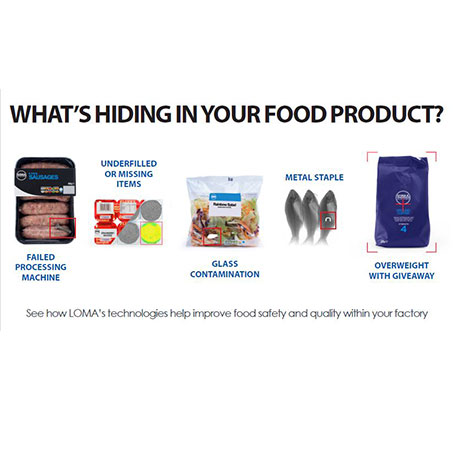The Good, the bad and the ugly of food manufacturing
15 Dec 2017

Effective product protection is critical to all sectors of the food industry, ensuring safety and quality.
The Good - Designed to Survive® Inspection Equiptment
Despite global food processing, manufacturing and packing facilities boasting some of the toughest production environments, they also need to meet stringent hygiene and cleanliness standards. As a result, they demand innovative, durable and hygienic inspection equipment that withstands the harshest operating conditions. As the first company in the industry to receive an ISO9001 certification, Loma’s highly skilled engineers use their in-depth knowledge of these food industry challenges to develop robust and reliable inspection systems that adhere to the company’s ‘Designed to Survive’ ethos.With ‘Designed to Survive’ firmly embedded in the Loma culture, its high performance metal detectors, checkweighers and X-ray inspection equipment easily copes with the rigors of food processing environments, whilst protecting brand values and ensuring compliance with food safety regulations.
Delivering maximum uptime at a low lifetime cost of ownership, Loma systems are engineered to deliver industry-leading levels of product integrity for the busiest of food processing and packing lines. Loma inspection equipment, which is produced from high grade stainless steel, happily endures real-world production line conditions and the inevitable intensive cleaning processes needed to maintain hygiene standards.
Water and chemical damage from high pressure, high temperature wash down operations has a disastrous effect on electronics and is the principal cause of machine failure in food processing plants. For optimum durability and reliability, all Loma inspection models offer IP66 or IP69K ingress protection and enhanced resistance to static discharge. Belts are FDA/EU approved ensuring the entire system is designed to withstand rigorous washdown applications.
Loma machines will also operate accurately at low temperatures and are resilient to cold, which is crucial when many food production lines run in near freezing conditions.
The ingrained ‘Designed to Survive’ philosophy ensures customers continue to maximise production uptime, maintain self-sufficiency and comply with consumer and government demands for product safety.
The Bad - Contaminants
Ready meals and food-to-go products often contain multiple elements or ingredients packaged in different compartments, include additional items like cutlery or condiments, and have high salt content. Plus many snacks such as nuts and cereals fluctuate in density which can make it difficult to find foreign bodies. This can create inspection challenges for convenience food manufacturers.Loma’s X5c (compact) combination X-ray and Checkweighing unit is ideal for inspecting these products. The two integrated ‘detect and weigh’ technologies ensure food safety for brand protection, and consistency in weight, size and shape. Capable of weighing products while simultaneously inspecting for foreign bodies in one compact and easy to use format, the X5c X-ray combination system has been specially developed with ready meal and food-to-go processors and packers in mind.
The technologically advanced machine detects physical contaminants whilst ensuring perfect product presentation and quality assurance with fill level and seal inspection, mass measurement and component counts. It can also identify lumps of product including seasoning or powder.
Generally speaking bakery products are pretty easy to metal detect, but there can be a few that have higher moisture content which some metal detectors struggle with. Plus some packaging types are problematic to the vast majority of metal detectors in the market. The Loma IQ4 metal detector with its full range of operating frequencies overcomes this problem as it is able to tune out the ‘problematic’ signal and still obtain the very best possible detection criteria.
Metal detection has traditionally been widely used in the meat, poultry and seafood industry but processors are increasingly choosing more advanced inspection equipment that can also offer checkweighing functionality and enhanced quality control. Plus the highly conductive moisture content of meat products can adversely affect the performance of metal detectors, often making X-ray inspection a more viable option.
As a result, X-ray inspection systems are becoming a common fixture in meat processing plants throughout the world. Capable of detecting calcified bone, glass, dense plastic, rubber, stone as well as ferrous, non-ferrous and stainless steel metals, Loma’s X5 series of X-ray inspection equipment is ideal for raw, bulk, cold packaged and tinned meats, as well as on trend ready to cook lines or joints of meat packed in foil trays. Bone detection is where X-ray excels over other detection equipment as calcified bones are easier to detect in meat. Chicken is generally harder to handle as the relatively short lifespan of the bird means its bones have not calcified.
Loma’s X5 XL 800 X-ray system has been specially developed for in-line inspection of bulk meat products in euro crates or boxes weighing up to 100kg. The company’s PipeLine X-ray system provides good detection of contaminants in free flowing products including minced meat and slurries. The machine can be fitted into any existing pipeline system and integrated with the latest vacuum fillers and clipping and linking systems.
Confectionery applications pose a number of inspection challenges. An exceptionally wide range of ingredients are used, all of which are open to different types of contamination. High salt content of products might cause a disturbance of the detection field and metallised film and foil, which is normally used to package chocolate, can lead to a reduction in sensitivity. Proper portioning and seal integrity can be another concern as individual eggs or bars of chocolate might be underweight, overweight, deformed or broken.
The Ugly - Product Recalls
Food companies are increasingly reliant on high performance contaminant inspection equipment to guarantee the protection of consumers and significantly reduce the risk of costly brand and reputation damaging product recalls. This fear, together with stringent industry regulations, should make food safety top of the corporate agenda.Effective product protection is critical to all sectors of the food industry, ensuring that safety and quality continue to be vital hallmarks of today’s products.